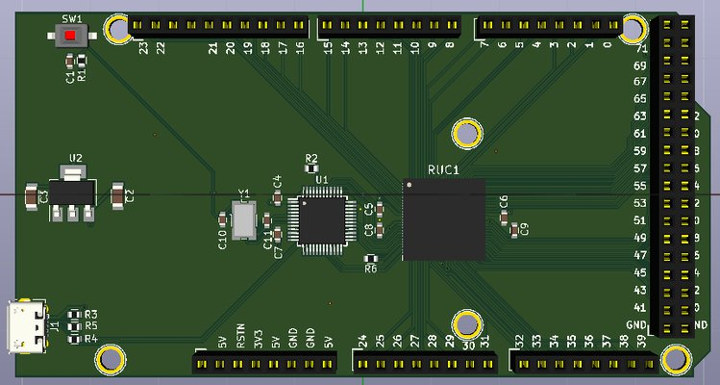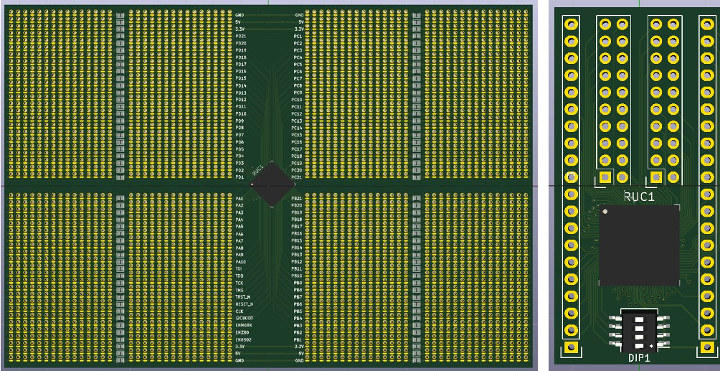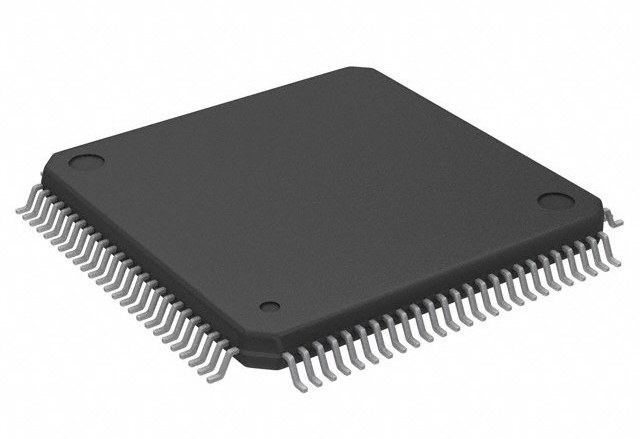If you’ve started your computing experience in the early eighties, you’ve probably used a ZX Spectrum, Commodore 64, and/or Atari ST home computers. Those products are long gone, except for collectors, but thanks to chips4makers project’s Zilog Z80, MOS 6502, and Motorola M68K cores are coming back to life via Retro-uC open source microcontroller.
As a bonus, developers also worked on Retrino, a board following Arduino Mega form factor, and featuring Retro-uC MCU, as well as Retro-uC ProtoPlus with the chip fitted to a large Perf+ 2 style prototyping board, and Retro-uC Breadboard which can be inserted into a standard breadboard.
Retro-uC Microcontroller
- Open source microcontroller with a Z80, MOS 6502 and Motorola 68000 core
- 4 kB of on-chip RAM
- 72x 5V digital general purpose I/O pins
- JTAG interface for programming the device
- Optionally bootable from external I2C flash memory
- I/O pins that can select the enabled core during reset
- One or more UART, I2C and PWM controllers
For reference, the Z80 core was found in the TRS-80 and ZX Spectrum, the MOS 6502 in the Apple I/II and the Commodore 64, and the Motorola 68000 in the Amiga and Atari ST.
The project promises to be developed in the open, with all code and PCB design released as open source. You’ll be able to follow the progress via the project’s blog.
Retrino
 If you don’t feel like designing your own board, Retrino board with Arduino MEGA form factor will feature the MCU.
If you don’t feel like designing your own board, Retrino board with Arduino MEGA form factor will feature the MCU.
Retrino specifications:
- Retro-uC QFP chip
- PCB with Arduino Mega compatible pin layout
- Only digital I/O, no analog
- STM32 companion chip
- USB interface for powering and programming the board
Note that only the hardware is compatible with Arduino, there’s no plan to implement support for Arduino IDE at this stage. You’d need to get your hands “dirty” with assembly or C programming.
Retro-uC ProtoPlus & Retro-uC BreadBoard

Two other boards will also be offered with:
- Retro-uC ProtoPlus, inspired by the Perf+ 2 board, and giving access to all I/O pins from the MCU via horizontal lines on the prototype board. all clearly marked with the pin names. Dimensions: 20 x 13 cm
- Retro-uC Breadboard, a breadboard-friendly board with the QFP chip, DIP switches to select active core and whether to boot from I2C, and headers to solder to the board yourself.
Crowdfunding
The project launched on Crowd Supply a few weeks ago, with a $22,000 funding goal. Retro-uC Chip in easy-to-solder QFP package is offered for $42, while $89 is asked for Retrino, $59 for Retro-uC breadboard, and $65 for the Protoplus board. They also have bundles with several boards and chips. Prices might seem on the high-side, but keep in mind the project does not benefit from the cost savings provided by high volume manufacturing. Shipping is free to the US, and ranges from free to $8 to the rest of the world depending on the selected perk(s). Rewards are expected for March or April 2019.
Thanks to SK for the tip.

Jean-Luc started CNX Software in 2010 as a part-time endeavor, before quitting his job as a software engineering manager, and starting to write daily news, and reviews full time later in 2011.
Support CNX Software! Donate via cryptocurrencies, become a Patron on Patreon, or purchase goods on Amazon or Aliexpress






So, an FPGA with an STM32F chip on a board? I guess the core emulation is the big part of the project as the hardware is pretty much OTC.
I’d really like to see a proper power/reset supervisor and SMPS on that board. Just throwing on a linear regulator and hoping the STM32 will cut it as a reset/supervisor doesn’t instill confidence that their hardware designer is very experienced.
The details on the kickstarter page suggests they have an FPGA now but this will be an ASIC. I.e. they say they’ll be taping it out, the core you want will be selected by a strap and a core file.
That said the chip is more expensive than a board with an FPGA that’ll house multiple 8 bit micros or a 68000.
If you really want a 68000 you can get one with a DRAM controller etc for a few bucks.
I have a tube of 68K’s in the basement. But at 0.9″ lead spacing, they’re not very breadboard friendly. 🙂 I have some PGA ones as well, but they’re even more hostile. 😉
I like the idea of an emulator core board like this, but it really needs to have some DRAM and standard I/O on it. Who wants to emulate just the processor? You need to emulate the whole system.
Well the C64 used a MOS 6510, although the VIC-20 used a 6502. There’s also the amstrads, atari’s, and so on.
But what made the 8-bit CBM and Atari machines in particular were the video and audio chips, the cpu is pretty useless by itself for any emulation.
Yes, no sense mentioning C64 if you don’t emulate SID (audio) VIC-2 (video) and maybe even CIA (I/O). SID being a mixed signal chip (analog & digital) and VIC-2 having some innovative sprite handling for the time.
Well, if it’s a clock-perfect cpu replica than it’s not useless — clock-perfect cpu emulation is a rather heavy task (think 3+GHz core i7 for a ‘puny’ 6502), so it’s more of a required-but-not-sufficient condition for emulation.
i’m need all
no only procesor
lokk at https://www.kickstarter.com/projects/954662076/gameshell-redefine-retro-game-console